
 Image: Michael Crider/IDG
Image: Michael Crider/IDG
History runs in cycles. And so, apparently, do trends in PC accessories. After about a decade of obsession with big, chunky, clicky mechanical keyboards, we’re starting to see manufacturers return to the thinner, sleeker designs seen in the early 2000s. But with two crucial differences: They’re bringing what they’ve learned from mechanical designs to these older form factors, and the prices are absolutely astronomical.
So it is with the Corsair K100 Air. This super-thin keyboard is the first desktop design to feature Cherry’s Ultra-Low Profile switches, otherwise seen in high-end gaming laptops. The result is a board that fuses the satisfying click and resistance of mechanical keys (albeit with much shorter key travel) with a visual aesthetic that might just be the slickest thing on the market.
The K100 Air is an acquired taste. You won’t like it if you prefer the chunky keycaps and long travel of the current zeitgeist, and the price tag is frankly ridiculous. But if you want a keyboard that looks better than it performs, and money is no object, you might be able to justify the cost.
Note: This review is part of our ongoing roundup of the best wireless gaming keyboards. Go there to learn more about competing products, what to look for in a wireless gaming keyboard, and buying recommendations.
At a glance
Expert’s Rating
Pros
Incredibly thinPrettySurprisingly good switches
Cons
Insane price Short battery lifeno wrist rest
Our Verdict
As a showcase of Cherry’s thinnest switches, the K100 Air is interesting. But it won’t outperform any gaming keyboard, despite being the most expensive one on the market.
Price When Reviewed
$279.99
Best Prices Today: Corsair K100 Air
RetailerPrice
 $279.99View Deal
$279.99View Deal
Skinny click
The most striking and unique feature of the K100 Air is those brand new ULP switches. Cherry combined elements of scissor switches found in high-quality laptop keyboards with a teeny-tiny spring, which sits horizontally instead of vertically.
The spring actually stretches out as you depress the key, instead of compressing down like a standard MX switch.
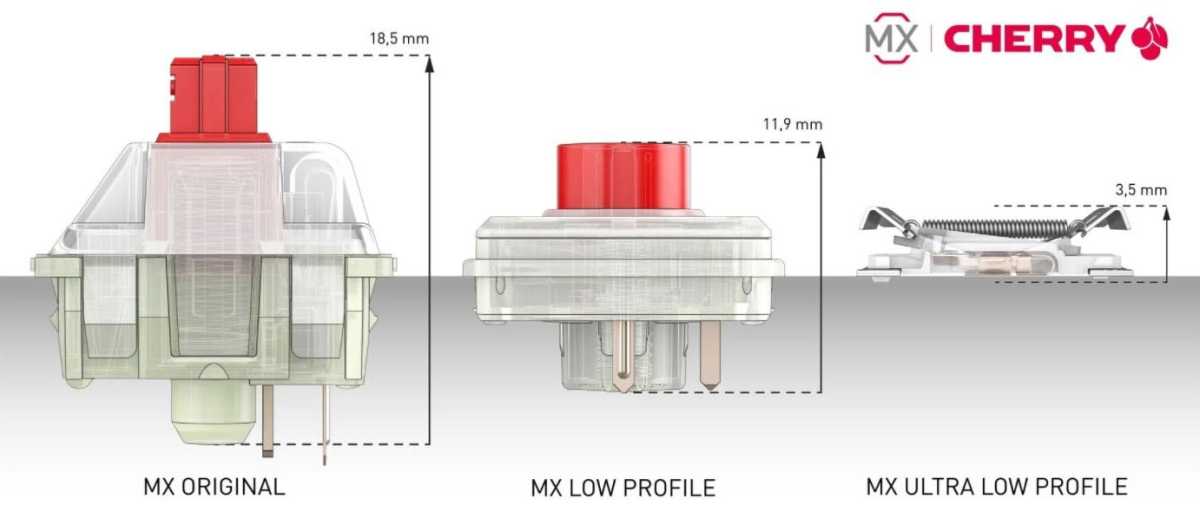
Cherry
Cherry
Cherry
The result is keys that feature surprisingly stiff resistance of 65 newtons with a travel of 1.8mm. For the sake of comparison, a standard MX Red switch has 45 newtons of resistance and 4mm of travel. Considering that the ULP switch is just 3.5mm tall, less than a quarter of the height of a standard switch, it’s an impressive bit of engineering. (And unlike the MX switch, it’ll be decades before anyone can legally copy the design—ka-ching.)
So considering just how much thinner the K100 is versus a conventional mechanical keyboard, it’s amazing how well it feels under your fingers. In fact at 16mm tall without the feet extended, the entire keyboard is thinner than one standard MX switch, even without a keycap. But neither Corsair nor Cherry can work miracles. The K100 Air feels good to type and game on, but it’s still essentially a laptop design in a full-sized desktop keyboard, and you shouldn’t expect more than that. It’s a really, really nice laptop keyboard, and the stiff, springy keys feel better than anything close to this design with a membrane structure, like the Apple Magic Keyboard or even the Lenovo ThinkPad TrackPoint Keyboard.
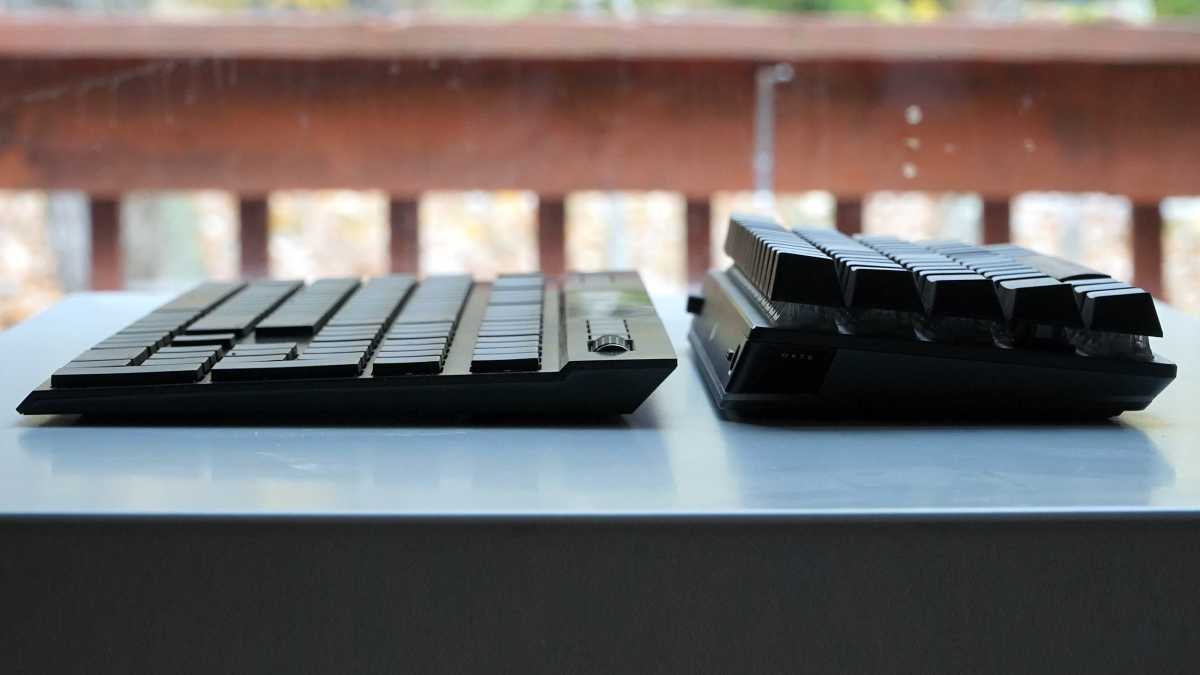
Michael Crider/IDG
Michael Crider/IDG
Michael Crider/IDG
Even so, gamers and typists who’ve grown accustomed to more regular mechanical boards might take a while to transition to the thinner setup. I had trouble getting into a groove based on the height of the deck alone, even with the double-stage feet extended. (And incidentally, Corsair, it’s awfully cheeky to make a keyboard this expensive and not include a wrist rest.) If you’re considering the K100 Air, I strongly suggest you try it out in a retail store or test the identical key switches on the new Corsair Voyager or Alienware M15 or M17 (where it’s a pricey upgrade) before putting down nearly $300 on this keyboard.
Oh, and one last thing: The design of the Cherry ULP switches is such that you won’t be able to take off or replace the plastic keycaps, so customization options are out the window. You’d better hope the finish of the keys stands the test of time.
The rest of the board
Aside from the new key tech, the K100 Air has just about every feature Corsair could pack into its skinny frame. There’s ultra-low latency wireless via a 2.4GHz USB dongle, Bluetooth if you’d rather go without, and four-device pairing to switch between them. The keys light up with the usual RGB goodness (albeit not as bright or shiny as some alternatives), and there’s a nice selection of media controls next to the all-metal volume wheel.
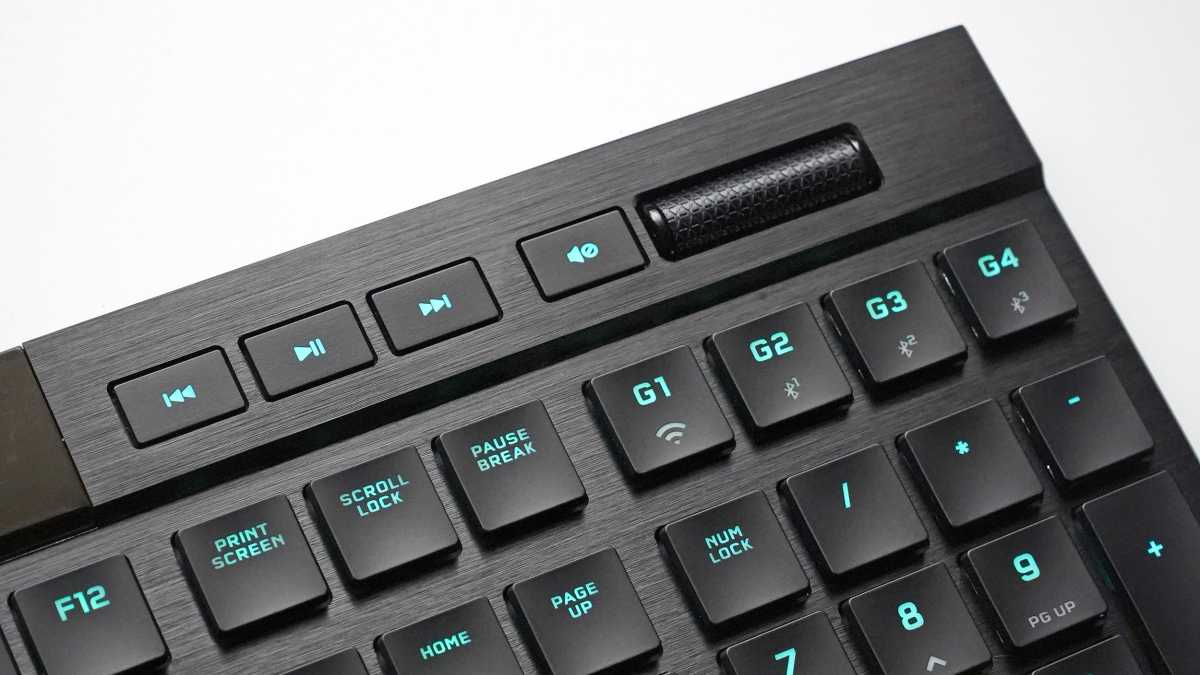
Michael Crider/IDG
Michael Crider/IDG
Michael Crider/IDG
Corsair is ostensibly a gaming brand, and gamers won’t find the keyboard lacking. In addition to 2,000Hz polling in USB wireless mode, you can crank it up to an insane 8,000Hz if you plug in the USB-C cable. The iCue software will let you customize the layout (including the Fn key!), profiles, and macros, complete with onboard storage, and even a PlayStation Mode if you want to use it with your console. Other smart additions include the option to customize the sleeping timeout duration (crucial if you’re using lighting all the time), connect multiple Corsair wireless devices via the Slipstream dongle, and even add some basic Elgato streaming controls.

Michael Crider/IDG
Michael Crider/IDG
Michael Crider/IDG
And of course, there’s the lighting. In contrast with the Roccat Vulcan II, which gives you absolutely dazzling keyboard lights and stubbornly refuses to sync them with anything not connected to your PC, the K100 Air gives you relatively tame keyboard lights that will connect to a wide array of extra gadgets. In addition to Corsair’s RGB gaming mice, headsets, case fans, RAM, mouse pads, and probably doggie beds at this point, the company sells a wide and expensive range of room lighting with which to sync animations. Go nuts, because Corsair already did.
mentioned in this article
Roccat Vulcan II Mini
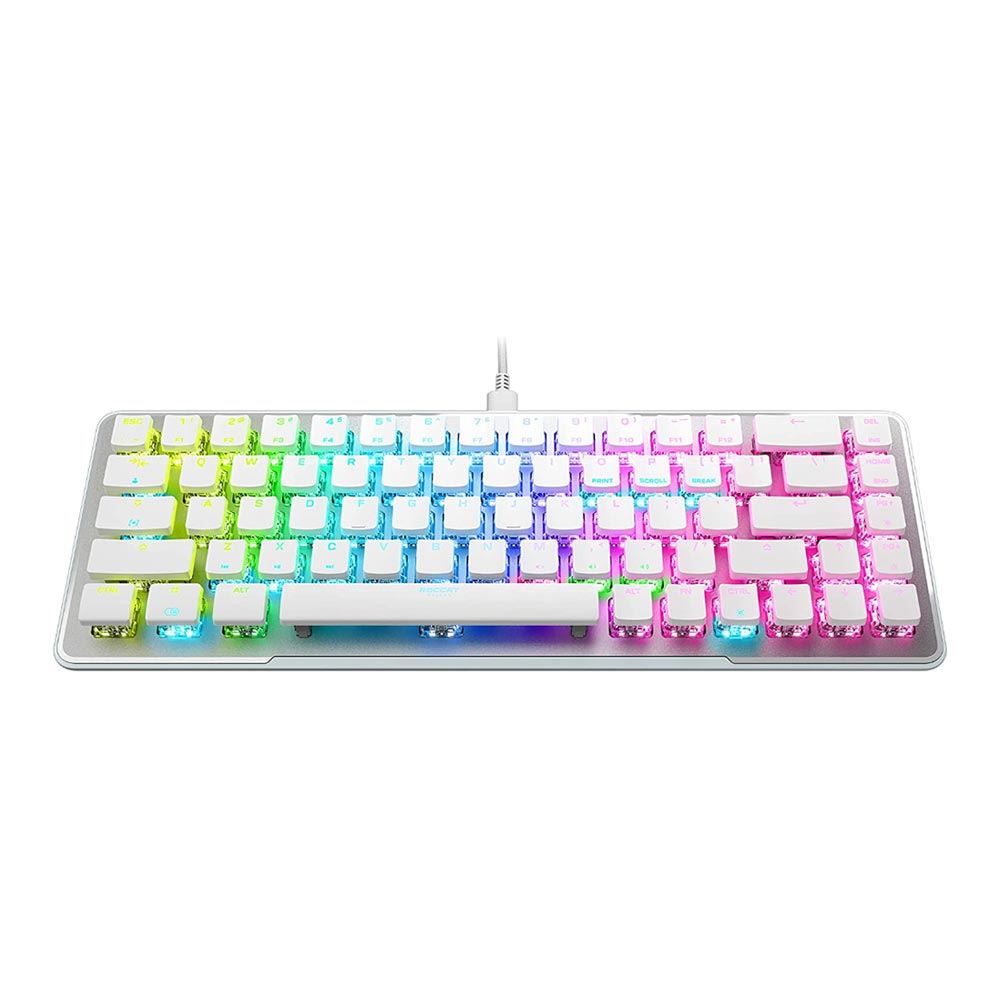 Read our reviewPrice When Reviewed:$150Best Prices Today:$150 at MicroCenter
Read our reviewPrice When Reviewed:$150Best Prices Today:$150 at MicroCenter

Michael Crider/IDG
Michael Crider/IDG
Michael Crider/IDG
Combined with a minimalist, all-black body covered in brushed aluminum, the result is admittedly gorgeous. This is the kind of keyboard that Hollywood set designers drool over when they’re building a movie version of a “hacker’s workstation.” Or perhaps for a more timely example, a Twitch streamer’s sponsor-laden setup, complete with the best (or at least most expensive) of everything. It’s pretty, is the point I’m making here. And if that’s your primary motivation for buying a keyboard, then you’ll buy the K100 Air and be happy. Just be aware that it might look a lot nicer than everything else on your desk, as is the case with mine.
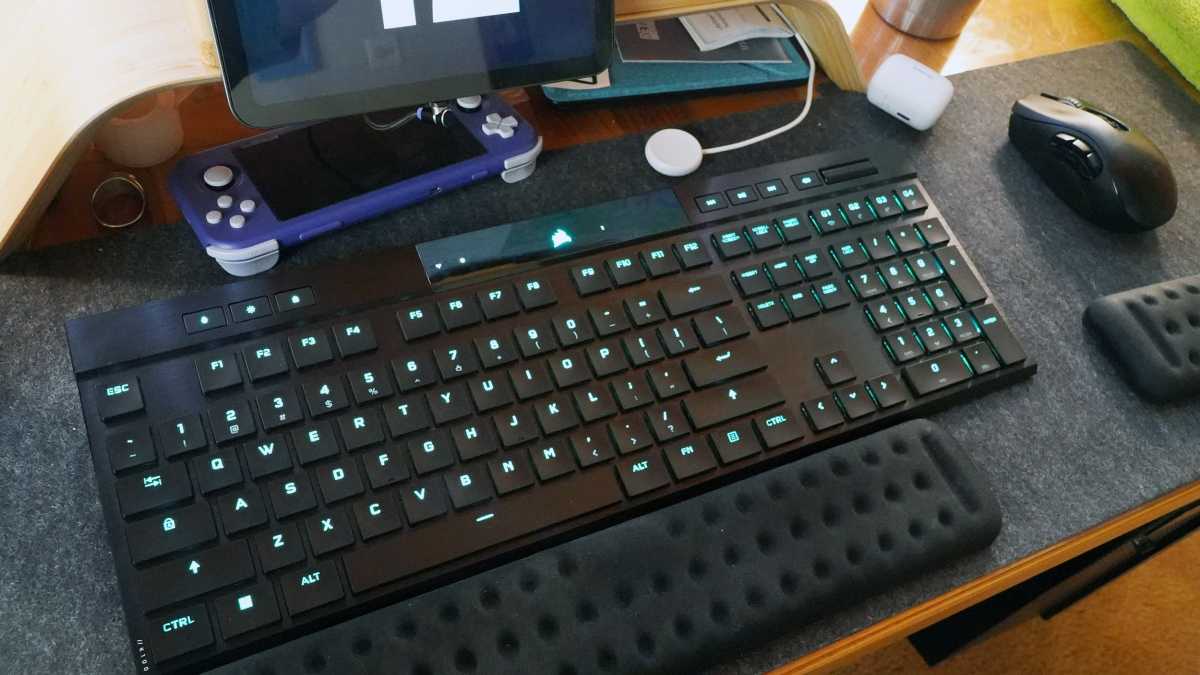
Michael Crider/IDG
Michael Crider/IDG
Michael Crider/IDG
If there’s one downside of the keyboard’s super-sleek body, it’s the battery. While you can probably use it wirelessly for months at a time if you can resist the urge to have the RGB lights react to your every loving keystroke, I found that it died after about a week of use with the lights on. That’s probably not a deal breaker for gamers, but it is fairly light (har har) in comparison to the competition.
Sticker shock
Which brings us to the least believable part of the K100 Air’s spec sheet: the price tag. At $279.99 it’s easily the most expensive of any mainstream gaming keyboard (not counting the boutique models), with a solid 10 percent premium over its similarly wireless and low-profile competition like the Razer Deathstalker V2 or the Logitech G915. Even if you can stomach the idea that it’s “only a little more expensive,” we’re still talking about almost $300 for a keyboard, which makes my pro-consumer bile rise.
For this price you’d assume that maybe Cherry is pricing each one of its patent-protected ULP switches like its own beloved child. Either that, or Corsair thinks that gamers are willing to pay just about anything to have a good-looking, ultra-thin keyboard that still counts as mechanical. In either case, I find the price unjustifiable, and it makes it impossible to recommend when there are wireless mechanical keyboards that are less sleek (but every bit as functional) for half the price.

Michael Crider/IDG
Michael Crider/IDG
Michael Crider/IDG
The K100 Air is remarkable for its dimensions, its typing experience, and its appealing looks. But I can’t help but wonder who it’s actually meant for: Most gamers will prefer more conventional mechanical keys with a longer travel, and anyone else will balk at the exorbitant price. Maybe if Corsair comes out with a more compact model that can fit in a carry-on bag it’ll be compelling as a super-premium tablet keyboard—after all, it costs about as much as an Apple design.
But for everyone else, it’s just too niche and too expensive. I’m excited to see these Cherry ULP switches show up in more gaming laptops, maybe even mainstream laptops that just want a nice typing experience. But that’s probably where they should stay—gaming keyboards can do without the space-saving, and without the expense.
Best Prices Today: Corsair K100 Air
RetailerPrice
 $279.99View Deal
$279.99View Deal
Author: Michael Crider, Staff Writer

Michael is a former graphic designer who’s been building and tweaking desktop computers for longer than he cares to admit. His interests include folk music, football, science fiction, and salsa verde, in no particular order.
Recent stories by Michael Crider:
This award-winning Corsair keyboard is an even better deal todayGet Corsair’s tiny, wireless, $150 hot-swap keyboard for just $64Get one of my favorite pro-grade mechanical keyboards for 53% off



